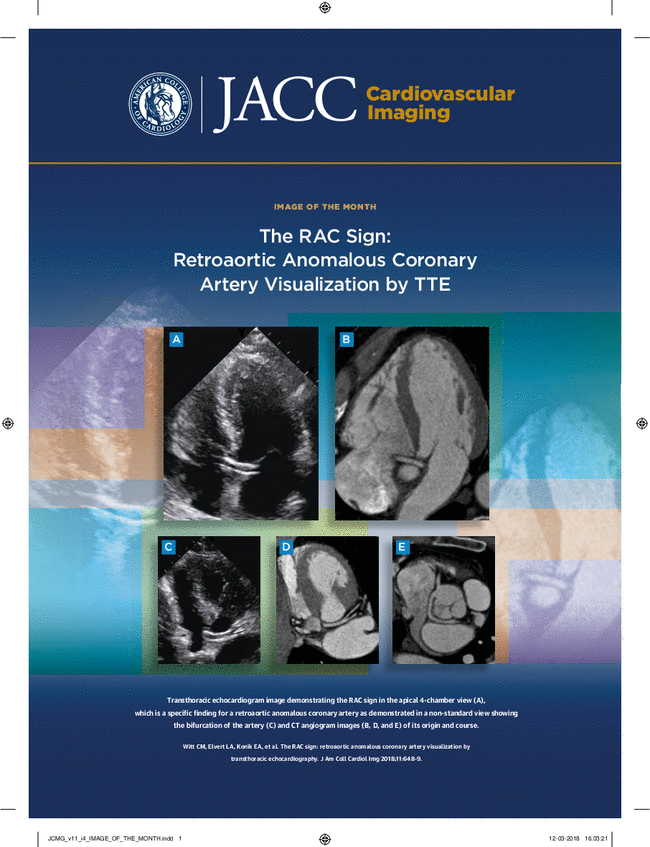Early Detection of Transthyretin Cardiac Amyloidosis Using 124I-Evuzamitide Positron Emission Tomography/Computed Tomography
IF 12.8
1区 医学
Q1 CARDIAC & CARDIOVASCULAR SYSTEMS
引用次数: 0
Abstract
Background
Early detection of transthyretin cardiac amyloidosis (ATTR-CA) is vital, because currently available therapies are most effective early in the disease course. Although Perugini grade 2 or 3 uptake on scintigraphy using bone-avid tracers such as 99mTc-pyrophosphate is highly specific for ATTR-CA, absent monoclonal proteins, sensitivity is about 70%. Positron emission tomographic (PET)/computed tomographic (CT) imaging using the novel radiolabeled heparan sulfate proteoglycan–binding peptide 124I-evuzamitide has been shown to be useful for quantifying cardiac amyloid load in systemic amyloidosis.
Objectives
The aim of this study was to quantify myocardial 124I-evuzamitide PET uptake and compare diagnostic performance with that of 99mTc-pyrophosphate in patients with ATTR-CA and carriers.
Methods
Twenty-five subjects underwent imaging using 124I-evuzamitide PET/CT imaging: 7 with wild-type ATTR-CA (all Columbia stage I) and 18 transthyretin amyloidosis (ATTR) variant-allele carriers with cardiomyopathy and/or neuropathy. Myocardial uptake was determined as left ventricular percentage of injected dose (mean activity concentration × volume/injected activity) and cardiac amyloid activity (mean specific uptake value × volume) within voxels with uptake above blood pool.
Results
Eleven subjects with ATTR and Perugini grade 0 or 1 99mTc-pyrophosphate cardiac scans had cardiac uptake of 124I-evuzamitide, suggesting that 124I-evuzamitide PET/CT imaging may detect ATTR amyloid deposits when 99mTc-pyrophosphate cardiac scintigraphy does not. 124I-evuzamitide showed myocardial uptake in all 5 subjects with variant ATTR with biopsy-proven disease and in 2 subjects with wild-type ATTR and negative (grade 0) results on 99mTc-pyrophosphate scans but extracardiac biopsies showing ATTR. Myocardial amyloid load was moderately to strongly correlated with disease stage and with echocardiographic and quality-of-life measures.
Conclusions
124I-evuzamitide PET/CT imaging can identify myocardial amyloid in variant transthyretin allele carriers and wild-type subjects when 99mTc-pyrophosphate does not. (Evuzamitide in PET/CT to Measure Potential Therapeutic Response in ATTR; NCT05635045)
124I-Evuzamitide正电子发射断层扫描/计算机断层扫描早期检测转甲状腺素型心脏淀粉样变性。
背景:早期发现甲状腺素型心脏淀粉样变性(atr - ca)是至关重要的,因为目前可用的治疗方法在病程早期最有效。尽管使用骨示踪剂(如99mtc焦磷酸盐)的闪烁成像显示Perugini 2级或3级摄取对atr - ca具有高度特异性,但缺乏单克隆蛋白,敏感性约为70%。使用新型放射性标记硫酸肝素蛋白多糖结合肽124I-evuzamitide的正电子发射断层扫描(PET)/计算机断层扫描(CT)成像已被证明可用于定量系统性淀粉样变性的心脏淀粉样蛋白负荷。目的:本研究的目的是量化心肌124i - evuzamittide PET摄取,并与atr - ca患者和携带者99mtc -焦磷酸盐的诊断性能进行比较。方法:25例患者接受124I-evuzamitide PET/CT成像:7例为野生型atr - ca(均为哥伦比亚I期),18例为转甲状腺素淀粉样变性(ATTR)变异等位基因携带者,伴有心肌病和/或神经病变。心肌摄取测定为左心室注射剂量的百分比(平均活性浓度×体积/注射活性)和心脏淀粉样蛋白活性(平均特定摄取值×体积)在血池以上摄取的体素内。结果:11名ATTR和Perugini 0级或1次99mtc焦磷酸盐心脏扫描的受试者心脏摄取124I-evuzamitide,表明124I-evuzamitide PET/CT成像可以检测到ATTR淀粉样蛋白沉积,而99mtc焦磷酸盐心脏扫描不能检测到。124I-evuzamitide在所有5例活检证实疾病的变异型ATTR患者中显示心肌摄取,在2例野生型ATTR患者中,99mtc焦磷酸盐扫描结果为阴性(0级),但心外活检显示ATTR。心肌淀粉样蛋白负荷与疾病分期、超声心动图和生活质量指标呈正相关。结论:124I-evuzamitide PET/CT成像可以识别变型甲状腺素等位基因携带者和野生型受试者的心肌淀粉样蛋白,而99mtc -焦磷酸盐不能识别。用evuzamit肽检测ATTR患者的潜在治疗反应NCT05635045)。
本文章由计算机程序翻译,如有差异,请以英文原文为准。
求助全文
约1分钟内获得全文
求助全文
来源期刊

JACC. Cardiovascular imaging
CARDIAC & CARDIOVASCULAR SYSTEMS-RADIOLOGY, NUCLEAR MEDICINE & MEDICAL IMAGING
CiteScore
24.90
自引率
5.70%
发文量
330
审稿时长
4-8 weeks
期刊介绍:
JACC: Cardiovascular Imaging, part of the prestigious Journal of the American College of Cardiology (JACC) family, offers readers a comprehensive perspective on all aspects of cardiovascular imaging. This specialist journal covers original clinical research on both non-invasive and invasive imaging techniques, including echocardiography, CT, CMR, nuclear, optical imaging, and cine-angiography.
JACC. Cardiovascular imaging highlights advances in basic science and molecular imaging that are expected to significantly impact clinical practice in the next decade. This influence encompasses improvements in diagnostic performance, enhanced understanding of the pathogenetic basis of diseases, and advancements in therapy.
In addition to cutting-edge research,the content of JACC: Cardiovascular Imaging emphasizes practical aspects for the practicing cardiologist, including advocacy and practice management.The journal also features state-of-the-art reviews, ensuring a well-rounded and insightful resource for professionals in the field of cardiovascular imaging.
 求助内容:
求助内容: 应助结果提醒方式:
应助结果提醒方式:


